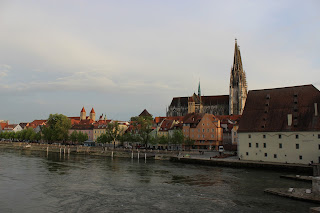Regensburg and Remembrance
Almost 25 years ago, when we were living in Hungary, our friend, novelist Denise Giardina, came to visit us from her home in West Virginia. She was writing a novel about theologian Dietrich Bonhoffer and the White Rose, a group of students at the University of Munich who led an anti-Nazi resistance movement during the Second World War. She wanted to visit the concentration camp where Bonhoffer had been held and ultimately killed, and to interview an elderly monk who had known him. Since Denise didn’t speak German and I had enough of the language to stumble on, I went with her on her visits and helped translate what we saw and heard. One of the places we visited was Regensburg, where Bonhoffer was held before being executed at the nearby Flossenbürg Concentration Camp.
Denise went on to write a magnificent book – Saints and Villains – and I went back to my life in Hungary and later Charlottesville. I hadn’t thought much about our trip since – at least not the specifics of it. In fact, I had completely forgotten that Regensburg was one of the places we had visited.
 It came back last week, when Regensburg appeared on our map (and weather forecast) as a nice stopover on our nine-day trip from Prague to Milan, Italy, where we are planning to meet a friend on Monday. Regensburg allows campers to spend the night in a municipal parking lot right across the Rhine River from downtown, a great base for our exploration of the medieval churches and interesting architecture of this southern German city.
It came back last week, when Regensburg appeared on our map (and weather forecast) as a nice stopover on our nine-day trip from Prague to Milan, Italy, where we are planning to meet a friend on Monday. Regensburg allows campers to spend the night in a municipal parking lot right across the Rhine River from downtown, a great base for our exploration of the medieval churches and interesting architecture of this southern German city.
The name rang a bell, but the downtown area didn’t seem familiar. We explored narrow medieval streets and marveled at the age and beautiful condition of the buildings. Finally, we arrived at the Gothic Cathedral, begun in the year 1273 and a prime example of the over-the-top church architecture of the time.
As we circled from the back of the church to the front, we discovered a crowd of people carrying banners and listening to speeches on the steps leading up to the grand wooden door. About a dozen people held a long banner with the names of 65 people and the dates March 23-April 25, 1945.
One of them explained to us that those 65 people were killed in the Colosseum, a dance hall in the middle of town that served as a sub-camp of the Flossenbürg Concentration Camp. They were gunned down by the Gestapo in the last days of the Nazi regime, among 400 prisoners who were forced to march from Flossenbürg ahead of the Allied advance. Suddenly I remembered that previous trip, and the terrible role Regensburg had played in the war.
After the speeches at the Cathedral were done, the 250-some people – old and young – marched to the site of the old synagogue, then to the new synagogue, then to the Jehovah’s Witness Kingdom Hall and other sites of remembrance, as they do every year.
This is how Regensburg remembers the horrors of the Nazi regime, and how they vow every year that the ideas of fascism, racism and nationalism will not be allowed to gain a foothold there again. And the groups represented by the banners – LGBT rights groups, Jewish groups, youth groups – continue to organize throughout the year to make sure that vow is honored.
It reminds me of a more recent tradition that began a few years ago in Charlottesville: Liberation and Freedom Day. On March 3, we march from the University of Virginia to Downtown to mark the day that Union troops liberated Charlottesville and the enslaved residents – more than half the town – were freed after 300 years of slavery. From opposing armed racist and fascist protesters last summer to the daily work of organizing and advocating, Charlottesville people put those vows to work in the community every day.
We need to commemorate these events to remind ourselves of the terrible things that have been done in our names, in our communities, and to vow that we will not allow them to happen again. And we need to work every day to make those vows a reality. In both Europe and the US, fascists and racists continue to try to organize to reassert their tenets of hatred, exclusion and violence. It falls on the rest of us to work tirelessly to make sure they fail. The people of Regensburg and Charlottesville offer a great example of how.






Comments
Post a Comment